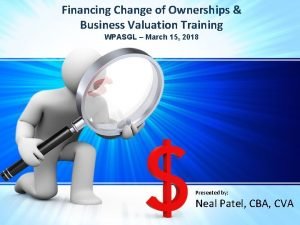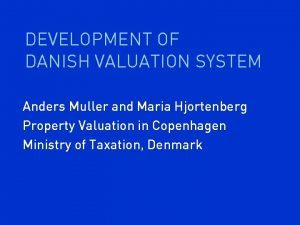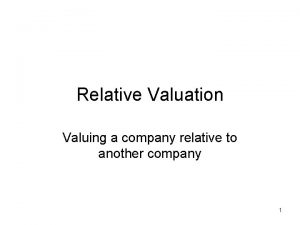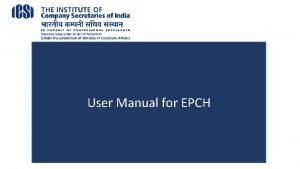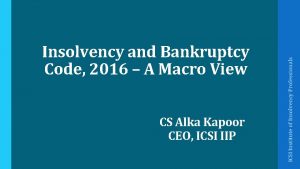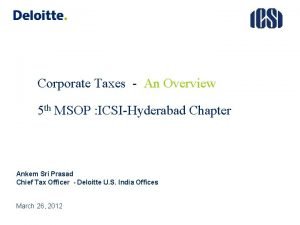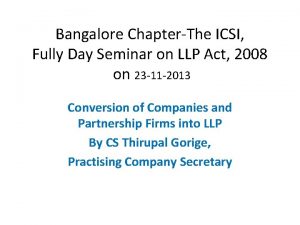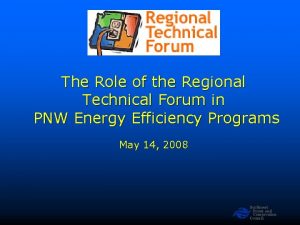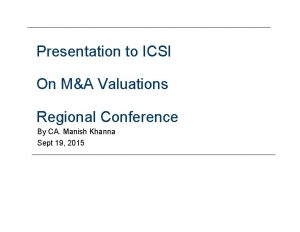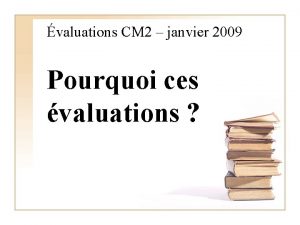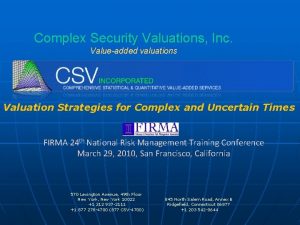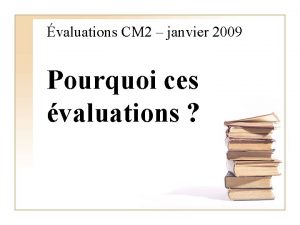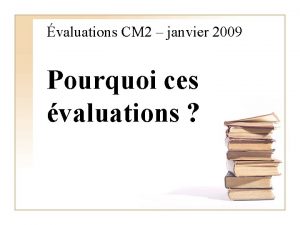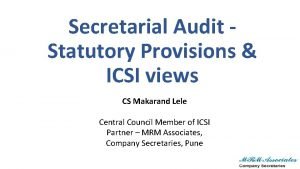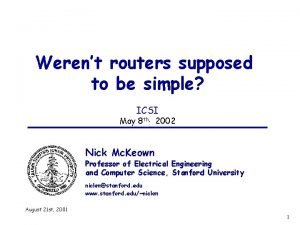Presentation to ICSI On MA Valuations Regional Conference




























- Slides: 28

Presentation to ICSI On M&A Valuations Regional Conference By CA. Manish Khanna Sept 19, 2015

Overview of the Presentation Agenda I. Introduction to M&A related Valuation II. Dynamics of M&A Valuation III. A. Drivers of M&A and Role of an Investment Banker B. Valuation Methodologies and the “Football Field” IPO Valuation A. What Matters and is Most Important? B. In-depth IPO Valuation

Introduction to M&A related Valuation

Valuation Overview Introduction to Valuation is a Central Discipline in Investment Banking ¡ Nearly Every Activity in Investment Banking and Private Equity is Driven by Valuation Analyses } Determining the value of the Company is generally the first step – M&A ⇛ Determining the value in a transaction – Equity Capital ⇛ Pricing the Initial Public Offering – Leveraged Finance ⇛ Determining collateral value and/or financing capacity } Securities design and pricing is an extension of the same fundamental concepts ¡ Valuation Requires the Interpretation of Information and Sound Judgment (Balance of “Science” & “Art”) } Information provides a foundation of knowledge about the asset and the marketplace } Interpretation of the information and correct judgment distinguishes the quality of the analysis ¡ At the Core, Valuation is About Finding the Equilibrium Between Risk and Reward } Fair market value is typically defined as the price at which a willing buyer and a willing seller will transact around an asset / company when both have complete information and neither is under any compulsion to act } Obviously, buyers and sellers may value assets differently based on a variety of factors, thereby creating a market 1

Valuation Overview (Cont’d) Introduction to Valuation Definition of Key Terms ¡ Firm Value (or “Enterprise Value”) } The total value of an operating business regardless of its capital structure ¡ Equity Value (or “Market Value of Equity”, “Market Value” or “Market Cap”) } The value of an operating business to its equity holders } The value of an operating business after the satisfaction of its creditors and preferred claim holders Firm Value less Net Debt equals Equity Value ¡ Net Debt } The sum of: – Total indebtedness for borrowed money – Preferred claims against the value of the business } Less the sum of: – Cash and cash equivalents ¡ Preferred Claims against the Value of the Business } May include preferred stock, “out-of-the-money” convertible securities or minority interests 2

Valuation Overview (Cont’d) Introduction to Valuation Definition of Key Terms @ M&A Control Value ¡ Typically involves a premium over the publicly traded equity value } Ability to control the Board, management and strategy of the business } Ability to integrate with other assets and capture synergies } Ability to access all cash flows and create the optimal capital structure ¡ Commonly represented by publicly traded equity value @ Trading @ IPO Fully Distributed Equity Value IPO Value } Assumes adequate liquidity in the market } Generally subject to existing Board, management and strategy } Access to cash flow limited to dividends ¡ Typically involves a discount to the publicly traded equity value 3 } Discount reflects a lack of market history and therefore certain liquidity and valuation risk } Also reflects an attempt to “entice” shareholders of similar companies to buy IPO (bargain price)

Dynamics of M&A Valuation

Drivers of Mergers & Acquisitions M&A Valuation Why Deals Happen and Don’t Happen Why Deals Don’t Happen ¡ Compelling Strategic Rationale for a Transaction } Diversification vs. Focus (Broaden or Narrow Business Mix) } Manage Market Position and Scale (Commit to a Product / Market or Exit) } Geographic Expansion vs. Retrenchment (Globalization / Cost of Entry) } Vertical Integration vs. Outsourcing } Defensive (What If Our Competitor / Pursuer Wins? ) ¡ Insufficient Strategic or Financial Rationale ¡ Management / Board of Directors Resistance (Social Issues) ¡ Market / Shareholder Concerns (Dilution / Lack of Understanding / Credibility) ¡ Inadequate Financial Resources Available to the Buyers ¡ Anti-Trust Considerations ¡ Changes in Relative Valuation ¡ Compelling Financial Rationale for a Transaction } Low Relative Cost or High Relative Opportunity } Financing Markets (Ability to Leverage Equity Returns) } Equity Market Perception / Reaction (Valuation Metrics / Business Model / Growth / Profitability) } Financial Synergies (Different Value Available to Different Owners) } Financial Stress (Company Selling Subsidiary to Raise Cash) } Financial Sponsor Exit ¡ Accounting, Tax, Legal, and Environmental Issues Are Insurmountable ¡ Regulatory (Domestic or Abroad) ¡ Other Reasons } Management Ego } Change in Management 4

What are the Deal Mechanics and the Process? M&A Valuation Types of Deals and Structures Types of Deals and Processes Subsid. /Private Company Transaction Structures ¡ Exclusive Sale } Private Sale to a Single Buyer } Limited Auction (Formal vs. Informal) } Full Auction (Public vs. Private) ¡ Asset Sale } Transaction of specific assets and liabilities } Required if operations are not held in a distinct subsidiary or set of subsidiaries } Provides the buyer the ability to deduct transaction goodwill for tax purposes ¡ Buy-Side Mandate } Willing Target Pursuing a Sale Process } Unsolicited Approach – Target Attitude Unknown (Formal vs. Informal) – Friendly Negotiations – “Bear Hug” – Target is Resistant (Disclosure Issues) – Hostile Offer ¡ Stock Sale ¡ Equity Restructurings } Spin-off – shares of subsidiary distributed tax-free to all parent shareholders on a pro-rata basis } Split-off – shares of subsidiary distributed tax-free to self -selected parent shareholders } Targeted Stock – distributed tax-free in either manner outlined above or IPO’ ¡ Leveraged Buyouts and Recapitalizations 5

Role of a financial advisor M&A Valuation A financial advisor performs a broad range of functions in the M&A process ¡ Drive the Process – From “cradle to grave” ¡ Valuation Advice – Provide comprehensive financial analysis to formulate (buyside) or evaluate (sellside) a bid ¡ Diligence – Assist client in the completion of a thorough and organized diligence process ¡ Marketing – Assist client in preparing diligence materials and public / investor communications ¡ Structuring – Structure transaction to meet the needs of the parties ¡ Market Intelligence – Provide industry knowledge, a perspective on any public market activity and the ability to assess the likelihood of other potential bidders of the target ¡ Bidding Strategy – Advise the client on the best way to ensure success ¡ Financing – Arrange financing alternatives (if necessary) ¡ Negotiations – Increase negotiating flexibility and leverage by acting as a go-between with the other side ¡ Opinion – Deliver fairness opinion (if appropriate) ¡ Market Reaction – Anticipate market reaction and marketability of securities 6

What is a Football Field? M&A Valuation A football field summarizes the various metrics and assumptions used to determine the valuation of a company or business segment ¡ Fairness Opinion } Presents the range of “fair value” for a Board of Directors’ consideration in a sale context } Provides guidance to justify a bid value in a buy-side ¡ Sell-Side } Summarizes proposed positioning and target valuation range based on preliminary analysis ¡ Buy-Side } Demonstrates knowledge of the asset, suggests how other buyers might approach valuation and provides bid range guidance ¡ Internal Reference } For example – supports loan to value analysis when examining financing alternatives Important to remember that the valuation metrics used will vary depending on both the industry and the assignment 7

Summary of Valuation Methodologies M&A Valuation Multiple types of valuation analyses will be included in a valuation summary depending on industry, type of presentation, available information and numerous other factors Trading Value Control Value Private Co. Metric Considerations Trading Multiples ¡ Forward P/E, P/CF, EV/EBITDA, EV/Revenue most common – may show more than one metric Comparable Transactions ¡ LTM P/E, P/CF, EV/EBITDA, EV/Revenue most common – may show more than one metric. Operational metrics used too, particularly in commodity-oriented businesses Premiums Paid ¡ Make sure to apply premium to unaffected price (i. e. preannouncement or pre-leak) ¡ Alternatively, may apply premium to trading multiples Leveraged Buyout ¡ Choose appropriate target range of IRR ¡ Solve for price based on fixed leverage and range of exit multiples Discounted Cash Flow ¡ Option to show with and/or without synergies Sum-of-the-Parts ¡ Use for distinct business segments or individual assets with different value parameters Stock Price Trading Ranges ¡ Used as reference point ¡ 52 -week most common; also 3 -months, 6 -months, period since significant event Equity Research Price Targets ¡ Used as reference point ¡ High/low research price targets; check length of time forward and ensure consistent (or discount back) 8

Source of the Assumptions / Data M&A Valuation An analysis is only as good as its inputs The Projections ¡ Consideration must be given to which projections to use – can present multiple cases or one case only ¡ Fairness opinion valuations may involve a base case and a downside and should be provided by or blessed by management ¡ Buy-side valuations may involve management case and revised due diligence case ¡ If preliminary valuation, consider adding due diligence contingencies for unknown factors that may impact value The Key Assumptions ¡ Trading Comps: must have back-up for all analysis and consistently apply methodology (e. g. exclude finance subsidiaries, include / exclude underfunded pension liabilities, etc. ) ¡ Transaction Comps: be sure to use publicly available data if creating a fairness opinion for a public company; and be thorough in your search – have rationale for exclusion of deals ¡ Exit multiples: justify LBO and DCF exit multiples through trading and transaction comps or cycle analysis ¡ WACC: perform a detailed WACC analysis to justify discount rates for DCF ¡ Leverage: discuss leverage assumptions to make appropriate LBO valuation ¡ Premiums: clearly define the transaction size, time period and reference point of premiums used in analysis ¡ Share count: use exercisable or outstanding options where appropriate ¡ Change in Control Costs: review proxy materials to determine if change in control costs are relevant Always keep good back-up of all data sources and assumptions 9

Determining Appropriate Valuation Ranges M&A Valuation Science, Art or Sanity? ¡ “Science” vs. “Art” } Market information; financial data } Mechanics of valuation methodologies ¡ “Art” Step Back and Look at the “Bigger Picture” } Valuation inputs and assumptions are based on industry knowledge, experience and common sense } Senior bankers and industry coverage will opine on the appropriate ranges and assumptions ¡ Individual valuation ranges may seem reasonable, but do they make sense with respect to one another? } i. e. , Transaction multiples vs. trading multiples ¡ Are assumptions consistent between methodologies? } i. e. , DCF or LBO exit multiples vs. trading multiples or transaction multiples ¡ Is the valuation range too wide or too narrow? Sanity Check ¡ Go back and check the assumptions and calculations } Are there any outliers in the comparable multiples? } Are the earnings drivers correct? (i. e. , FCFE & earnings for equity value multiples, EBITDA for enterprise value multiples) } Have I used the right share count (exercisable vs. outstanding options)? } Is implied perpetuity growth rate appropriate? } What metric does the industry trade on? 11

Preliminary Valuation – the “Football Field” M&A Valuation Preliminary Review of Valuation Parameters Enterprise Value ($MM): WACC: 8. 0%-10. 0% Terminal EBITDA Multiple: 10. 0 x Target 0% 2012 Accretion MLPs: 11. 0 x to 13. 0 x 2012 EBITDA MLPs: 10. 0 x to 12. 0 x 2013 EBITDA Exit Multiple: 10. 0 x IRRs: 10%-15% Exit Multiple: 10. 0 x IRRs: 17. 5%-22. 5% Initial EBITDA Multiple: 14 x – 16 x EBITDA Multiple Range: 8 x – 10 x 13

Preliminary Valuation Analysis M&A Valuation Purchase Price Ratio Analysis PPR Analysis 14

Discounted Cash Flow Analysis M&A Valuation DCF Analysis 15

Discounted Cash Flow Analysis (Upside Case) M&A Valuation ¡ The valuation below includes all of the potential expansion projects and is discounted at a 10% rate to account for the additional risk associated with un-contracted projects DCF Analysis 16

IPO Valuation

Comparable Company Analysis Defined IPO Valuation Comparable Company Analysis Explained ¡ The equity of fundamentally similar, or “comparable” companies tends to be valued on a relatively consistent basis by the public markets } Broadly speaking, if Company A competes in the same industry as Company B, using a similar business model, the equity markets are likely to value the two businesses in a relatively consistent manner ¡ The Comparable Company Analysis seeks to identify a group or “universe” of public companies which are deemed fundamentally comparable to the target and compares the “market trading multiples” of these companies to determine a range of value for the target, expressed in valuation multiples ¡ By analyzing certain key ratios and operating data for each of the comparable companies it is possible to determine how the comparable companies valued relative to their profitability, growth prospects, etc. } Public markets typically place premiums to companies which portrays growth and margin profiles better than those of industry average ¡ As Comparable Company Analysis is based on an analysis of currently publicly trading companies, valuations received by the comparable universe DO NOT typically reflect: } Premium a buyer must pay for control of a company in an M&A transaction; or } Discount the market may place on shares which are newly introduced in an IPO 23

Comparable Company Analysis Defined (Cont’d) IPO Valuation Most Widely Used Valuation Tool What is it? Use of Trading Multiples ¡ Fundamental valuation tool used for deriving Importance company value ¡ Initial Public Offering ¡ Helps in benchmarking performance and ¡ Buy-side M&A valuations across companies within a sector ¡ Sell-Side M&A ¡ Valuation tool based on how comparable companies are valued by the stock market as a ¡ Add-on financings multiple of profit, sales or other parameters ¡ Share repurchases ¡ Assumes that the stock market is relatively efficient ¡ Leveraged Buy-out in valuing comparable companies 24

Enterprise and Equity Value Multiples IPO Valuation Equity Value Multiples Enterprise Value Multiples ¡ Takes into account capital structure in decision making ¡ Focus towards quality of operation ¡ Denominator after interest expense ¡ Denominator before interest expense ¡ Main multiples are } EV / Sales } EV / EBITDA } EV / EBIT or EV / EBITA } EV / Capital Employed } EV / Subscribers (telecom, similar ratios based on operating figures in other industries) ¡ Unlevered Capital Structure } P/E ratio } Equity Market Value / Net Income } Price / Book ratio } Price / CFPS Summarize the Results ¡ Summary Statistics } Mean, Median, High Low (The Median is the most meaningful statistic because it will naturally screen outliers) ¡ Outliers should be evaluated and possibly eliminated 25

Comparison of Multiples IPO Valuation Choice of the Multiple Depends on Industry, Profitability, Accounting Regimes Multiple EV / Sales Advantage Disadvantage ¡ Meaningful for loss-making companies ¡ Does not take differences in profitability ¡ Very limited impact of into accounting differences EV / EBITDA ¡ No distortions based on different depreciation policies ¡ Does not take differences in capital expenditures into account EV / EBIT ¡ Valuation based on quality of operation ¡ Possible distortions based on different accounting policies EV / Capital Employed ¡ Based on invested capital, which determines potential earnings power ¡ Does not take differences in profitability into account ¡ Distortions through accounting differences P/E Ratio ¡ Focuses on earnings to shareholders ¡ Accounting differences may distort true measures of earnings Price / CFPS ¡ “Cash is king” ¡ Does not take differences in capital expenditures into account Price / Book ¡ Based on equity, which determines earnings power ¡ Does not take differences in profitability into account 26

Understanding Key Drivers of “Multiples” IPO Valuation Why Do Comparable Companies Differ in Valuation? ¡ Industry and Sector Outlook ¡ Competitive Position ¡ Research Views ¡ Historical Performance One of Key Indicators of Future Performance } Revenue Growth ¡ Cash Flow } Operating Margins ¡ Net Income ¡ Qualitative Factors Impact Market’s Belief of the Company’s Future Performance ¡ Regulatory Issues } Management Quality and Track Record } Corporate and Operating Strategy ¡ Environmental Issues } Ownership Profile ¡ Legal Issues Valuation ultimately assesses the present value of the potential future financial rewards Current trading valuations or “multiples” of a Company are a reflection of public market’s belief in the future financial rewards by owning the securities of the Company 27

What Else Matters in an IPO? IPO Valuation Many Factors are Evaluated at Time of IPO ¡ Peer Group: Clear peer group with sizeable number of companies } Only need one; none allows Company / Banks to define the “valuation / story” ¡ Liquidity: % of float vs. other comparable companies } Need adequate IPO size to attract institutional investors ¡ Growth: What are organic and acquisitive growth prospects of the Company? } How do those projects / returns compare vs. peers and how achievable / financeable are they? ¡ Stability vs. Volatility: Is Company’s business volatile, risky, stable, cyclical? } Ability to dampen volatility or smooth out earnings? Capital structure and risk policies ¡ Stage of Company: What stage is the Company experiencing in its life cycle? } Developing, nascent, growth, mature? } Capital structure and cash flow generation / reinvestment ¡ Capital Structure: Credit ratings and leverage vs. peers and appropriate levels for Company / industry ¡ Market Conditions at time of IPO ¡ Management, Board composition and PE backing ¡ Banking relationships and research coverage } Credit support and capital markets access in the future 28

Relative Benchmarking IPO Valuation Enterprise Value ($ in millions) 2010 A Reserves (million tons) Reserves / 38. 6 yrs 2011 E Prod. EBITDA CAGR: 2011 E – 2013 E 27. 8 yrs 25. 8 yrs 10. 0 yrs 2010 A EBITDA / ton ______________ Note: Peer group data as per company filing and Wall Street equity research. Market data as of 3/23/2011. Note: Company B data per Company’s projections. 31 29. 8 yrs

Relative Benchmarking: Balance Sheet Strength IPO Valuation 2011 E EBITDA Total Liquidity BB+ (Stable) Ba 1 (Stable) BB (Watch) Ba 2 (Watch) BB- (Stable) Ba 3 (Stable) 2011 E Cash Flow from Operations Total Debt/Net Debt/LTM EBITDA (1) BB- (Watch) B 1 (Stable) BB- (Pos) B 1 (Pos) B+ (Watch) B 2 (Stable) B+ (Stable) B- (Stable) Caa 1 (Stable) Caa 2 (Stable) BB- (Watch) B 1 (Stable) B+ (Watch) B 2 (Stable) BB- (Pos) B 1 (Pos) B- (Stable) Caa 2 (Stable) BB- (Stable) Ba 3 (Stable) BB (Watch) Ba 2 (Watch) B+ (Stable) Caa 1 (Stable) BB+ (Stable) Ba 1 (Stable) BB (Watch) Ba 2 (Watch) Total Debt Median 2. 2 x Net Debt Median 1. 9 x ______________ Source: Company information and IBES Estimates. Note: All companies per 12/31/2010 filings. 1. Total liquidity is calculated cash & cash equivalents as of latest balance sheet data plus remaining balance on companies’ revolving credit facility, including LOCs. 32

Current Trading Multiples IPO Valuation EV / 2011 E EBITDA EV / 2012 E EBITDA EV / 2013 E EBITDA Primary Comp Secondary Comps Others ______________ Note: IBES consensus estimates as of 3/23/2011. 33
 Legal and general mortgage valuation
Legal and general mortgage valuation Llc
Llc Reliant business valuation
Reliant business valuation Jeder valuations
Jeder valuations Ebdita
Ebdita Nacada region 9
Nacada region 9 Https://elearning.icsi.in
Https://elearning.icsi.in Icsi bareilly chapter
Icsi bareilly chapter Icsiiip
Icsiiip Msop icsi
Msop icsi Icsi - icsa london course
Icsi - icsa london course Icsi bangalore chapter
Icsi bangalore chapter Udin generate icsi
Udin generate icsi Nirc icsi
Nirc icsi Peer review of cs firm
Peer review of cs firm Icsi syllabus 2017
Icsi syllabus 2017 Infirngement
Infirngement Occipital brow presentation
Occipital brow presentation Leopold maneuver
Leopold maneuver Regional area network
Regional area network Torso organs
Torso organs Ace portal
Ace portal Universidad de panama azuero
Universidad de panama azuero Define covert prestige
Define covert prestige National vs regional
National vs regional Regional technical forum
Regional technical forum Organisational structure of regional rural bank
Organisational structure of regional rural bank Regional market characteristics
Regional market characteristics Disadvantages of regional integration
Disadvantages of regional integration


